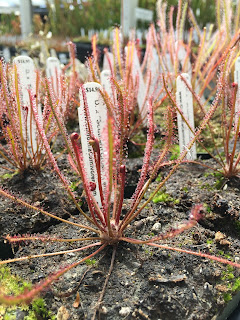The first time I ever heard of the telegraph plant was when I
was a kid and saw the 1951 version of "The Thing (From Another World)", a
highly acclaimed science fiction movie classic about a vegetable
humanoid monster invading the earth. There's a bit of dialogue when the
cast is discussing this "intellectual carrot" and some supposedly real
earthly botanical oddities are mentioned. They chat about the Century
Plant that lures small animals like squirrels with a sweet nectar,
traps them, and eats them. They mention the Telegraph Plant that can
communicate with others of its species miles away. It's surprising that
such a well done movie written by a famous screenwriter like Charles
Lederer would include such nonsense since these plants don't exist as
described. Commonly known real plants like the Venus flytrap would
have made more sense in the screenplay.
I next
came across the Telegraph Plant in high school when I read Charles
Darwin's 1880 "The Power of Movement in Plants". I was fascinated by Desmodium gyrans,
but never thought I would see one. Darwin studied this species rather
extensively but couldn't reach a viable conclusion as to why the plant
did what it did.
Desmodium gyrans is also known as Codariocalyx motorius, but
both Latin names are still used. While Telegraph Plant is its most
frequently used common name, it more recently has also been called the
Dancing Plant.
Native to the warmer southern countries
of Asia, it is a common bushy plant in the bean or legume family, and
its seed looks like tiny black eye peas with the color reversed
(blackish seed with white eyes). The branching stems produce elongated
single leaves a few inches long, with two tiny lateral leaves at the
base. When temperatures reach over 70 F (22 C), these two small lateral
leaves begin to move, or gyrate. The movement is rather slow but often
these small leaves are blocked by the petiole of the larger non-moving
leaf, causing them to jerk spastically and rather quickly. It's
fascinating and almost mesmerizing to watch.
Why does
it do this? Darwin couldn't figure it out, although he pondered whether
it was to "knock off" drops of rainwater that might collect on the
leaves. More recently it's been concluded that the lateral leaves are
searching or groping for the direction of the sun, and the larger single
leaves then tilt slightly to follow the sunlight, optimizing
photosynthesis. It's still controversial. At night when the plant is
sleeping (a major subject of his book was how plants sleep) all the
leaves droop downward.
Another odd thing that's been
discovered in recent years is that not only warmth instigates the
movement, but sound. Hence the name Dancing Plant. Sound, especially
high frequency sound, causes the lateral leaves to move more rapidly.
We've done minor experiments at the nursery with this, like talking
loudly or singing to the plant (music effects them well), and it does
seem that the leaves move much more quickly with sound. My singing
voice killed one plant (joke).
Another curiosity that
botanists, primarily in Europe, have found is that the Telegraph Plant
has some sort of "memory". Plants that have been grown in a
very quiet environment and then exposed to sound move at first very
slowly. Each time they are treated to music or singing or other sound,
the movement becomes more and more rapid.
Where did
the common name Telegraph Plant come from? Before cell phones, land
phones, and electronic telegraph machines, way back in the late
eighteenth century through the early 1900s, a French fellow named Claude
Chappe invented the "semaphore telegraph" as a means of communicating
over vast distances. "Semaphore" means "sign bearer" in Greek. On top
of towers clearly visible from some distance, he created shutters,
paddles or blades usually made of wood and that could be moved and
pivoted in different directions representing words or phrases. Using
telescopes, people could see and read these messages and pass them on
using their own semaphore telegraphs to communicate the information,
much like American Indians using smoke signals! Networks of these
telegraphs were strewn all over Europe and communication was much
quicker than by horseback. The electronic telegraph machines didn't
appear until the mid-1800s. The lateral leaves of Desmodium gyrans looked so much like the movement of semaphore telegraphs that the common name was given to the plant.
Telegraph plants are easy to grow. They are tropical so a warm and
sunny environment is necessary. They can often do well as a houseplant
or in warm greenhouses and outdoors in tropical climates. Use a
houseplant soil with better drainage, such as adding more perlite or
sand to the mix. Allow good drainage and don't keep the soil too wet
all of the time. It's often helpful to soak the seed in water for a
couple of days to speed up germination. Press the seed into the soil
and keep warm. Germination usually happens in a few to several weeks.
They grow fairly fast but have to be several inches high before the
"dancing leaves" are produced. They can reach three or four feet high
and wide. The primary pest we've encountered at California Carnivores
is mealybug, and sometimes aphids. One bit of warning, although there's
never been any reports of tragedy: this plant has small amounts of
alkaloids in them that are somewhat poisonous in large quantities, so
I'd keep animals like cats who eat houseplants away from them.
Fertilize occasionally like houseplants.
Small purplish
flowers appear that later turn into crusty dry pea-pod like fruit,
several seeds within each pod. Axel just harvested many hundreds of
seed which you'll find for sale on our web site. While not carnivorous,
it's another amazingly curious botanical oddity with a wonderful
history.











